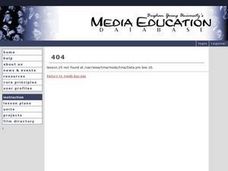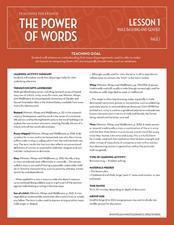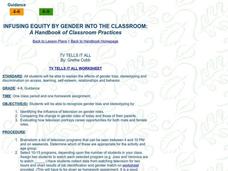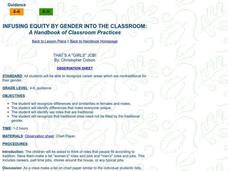Curated OER
Tortured Beauty
Young scholars compare and contrast two fundamentally different treatments of women, one Chinese and one Japanese, and to examine how this reflects on the culture that produced them.
Curated OER
What's on the Outside/Inside?
Students read about the idea of gender perspective in the writing of German history. They generate definitions from a list of given vocabulary words. They write definintions using their own words.
Curated OER
Woman Suffrage
Pupils are provided access to primary sources for a discussion of woman suffrage. They are introduced to the motivations, ideology, and organizations involved in woman suffrage. Students analyze primary documents including cartoons,...
Curated OER
Building a "Toolbox for Difference"
Students discover how race and gender relate to their sense of civic obligation. As a class, they create a 3-D toolbox for making a difference in their community or the world. They write an essay to accompany it explaining the design and...
Curated OER
True and Honorable Wives?
Young scholars discuss whether men or women are smarter. They divide into groups and review Act 2 of Julius Caesar and look for incidents of characters reading or mis-reading "signs", and making either wise or foolish decisions.
Curated OER
What If Things Were Different
Pupils understand how history is made, in terms of the individuals responsible for actions in the past and in terms of those in the present who preserve and interpret stories from the past.The subject matter relates to gender and sexual...
Curated OER
Girls Speak Out
Students discuss "education" and gender equity. They examine primary sources (video clips) of women/girls who do not have the privilege of an education. They create a pamphlet that will be used to publicize the issue of girls' education...
Curated OER
Gender and Media #1
High schoolers expand their knowledge to not focus on stereotypes. They practice using new vocabulary words and analyze different media for the use of stereotypes.
Curated OER
Gender and Media #2
Students are introduced to media literacy and deconstruction. They analyze the media's use of gender roles and body image. They voice their opinions about media messages and how to change them.
Curated OER
Gender and Media #3
Students identify media messages about gender and body image. They discuss how they can change these messages. They create their own media message about gender and body image.
Curated OER
Gender and Media Introduction
Students analyze media clips and discover how the media helps us form ideas about men and women and their roles in society. They discover some of their own preconceptions about these roles and answer questions.
Curated OER
Probability of a Boy
Learners investigate the concept of even change by participating in a coin flip activity. They research using the Internet to investigate the chance of giving birth to a boy.
Curated OER
Words in the News First Woman Leads Baltimore Orchestra
Students complete vocabulary activities including worksheets in order to read an online article. They discuss typical male and female roles in a variety of situations.
Curated OER
The Power of Words: Male Bashing and Gender
Students brainstorm words that typically describe men or women. They also brainstorm words that are insulting to both genders. They answer questions about the activity and discuss their answers.
Curated OER
Anti-Lynching Campaigns, 1890-1942
Young scholars examine the differences in opinion between black and white women about putting an end to lynching. They investigate how black activists encouraged white women to join them in their opposition to lynching.
Curated OER
Gender Roles
Students discuss gender roles and through case study, examine how gender roles can be learned and how they can be limiting. They research to find the names of both men and women who have become successful in various careers.
Curated OER
How Old Is Old?
Students explore longevity in the United States and the impact of one living longer. Statistics are used to identify life expectancy of an individual from his or her birth. Gender differences are investigated.
Curated OER
Infusing Equity By Gender Into the Classroom:
Students analyze personal perception of gender role assignments. They complete their "personal" point of view, then complete the "societal" view as a group.
Curated OER
Who Will Wear the Hats? Who Will Use the Tools?
Students recognize that there are many different jobs available in our society. They see that all people can, based upon an individual's natural abilities and interests, select any job regardless of gender.
Curated OER
Infusing Equity By Gender Into the Classroom
Students identify careers that are nontraditional for their gender.
Curated OER
INFUSING EQUITY BY GENDER INTO THE CLASSROOM
Students identify careers that are nontraditional for their gender.
Curated OER
DETERMINING THE EXISTENCE OF GENDER BIAS IN DAILY TASKS
Students identify task assignments by gender.
Curated OER
TV TELLS IT ALL
Pupils identify the influence of television on gender roles and talk about how they are changing.
Curated OER
THAT'S A "GIRLS" JOB!
Students identify the differences in males and females and examine how sex roles are traditional.

























